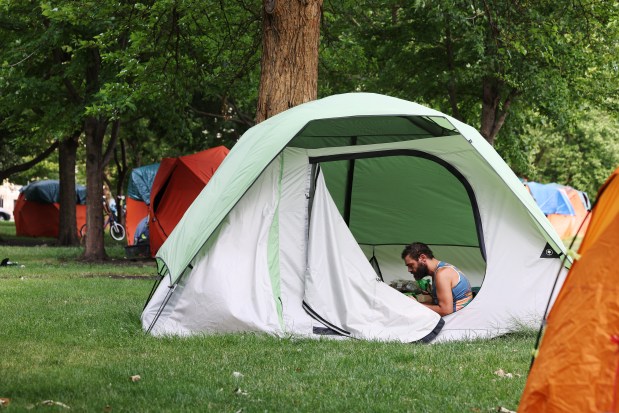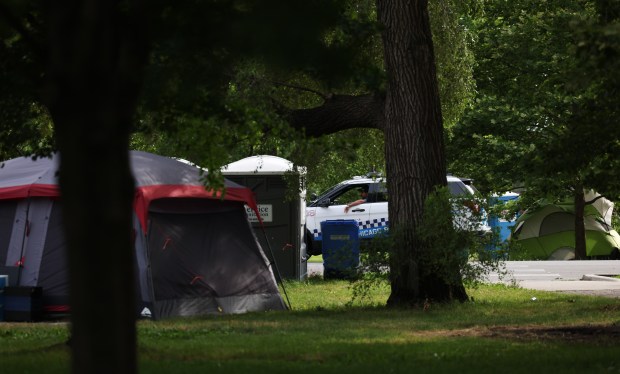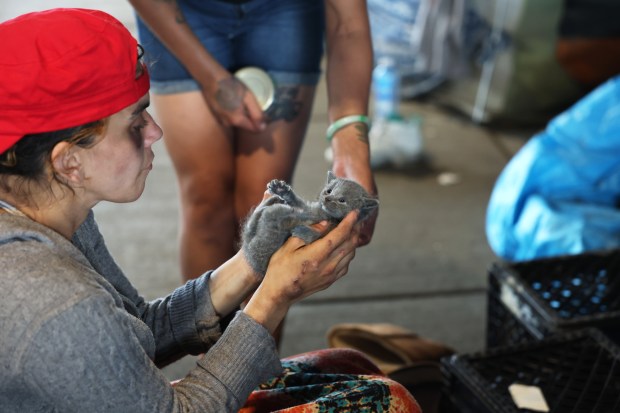Robert Bulanon glanced at the sky and frowned at the rain. He hurried into his home and emerged, holding an umbrella over his head, picking his way between a barbershop pole, a pair of bus seats, a wheelbarrow, a grill where another man was cooking beef stew, and other objects scattered along the embankment of the canal.
Bulanon, 52, is one of about 20 people who live in a set of makeshift shelters along the North Shore Channel between Foster and Bryn Mawr avenues on Chicago’s Northwest Side. A ladder leaned against the chain link fence, separating the river embankment from athletic fields at Northside College Prep, a selective enrollment high school.
By July 30, the residents will no longer be able to call the longtime encampment home. The next day, city departments are scheduled to begin clearing the tents and items, officials said, offering the group non-congregate shelter placement at a downtown hotel. Notices will go up starting the first week of July. The idea of relocating them has been talked about for years.
“They said, ‘We’re here to help; we could send you somewhere, a shelter or something,’” Bulanon recalled of his first interaction with the city.
Months after voters rejected the Bring Chicago Home referendum, which sought to raise millions for homelessness services by raising the city’s real estate transfer tax for property sales above $1 million, Chicago is at a critical juncture on how to address its rapidly growing homeless population.
The city has historically prioritized finding housing for its homeless, many of whom reside in tent cities across its parks and under bridges. But with low affordable housing stock, depleted federal and state funding and other challenges, the city’s number of homeless is outpacing what the city can provide.
On Friday, the U.S. Supreme Court ruled that cities and states can enforce bans on homeless people sleeping outdoors, which has experts and advocates for the homeless worried that accumulating citations and criminal proceedings could raise even higher barriers to housing and stability for people who started out with no place to go.
“Essentially, anytime a person sleeps in public with anything like a blanket or a pillow, or — Justice Sotomayor noted in her dissent — maybe a rolled up sweatshirt — they seem to fall under this law, which prohibits doing that,” said Northwestern University law professor Stephanie Didwania.
In an interview with the Tribune, Sendy Soto, Chicago’s chief homelessness officer, said the homeless in Chicago had nothing to fear from the ruling. The city plans to stick with its housing-first approach to getting homeless people off the streets.
“It is absolutely not our plan to focus on any type of incarceration,” she said. “We really want to ensure that our unhoused community does not find this to be a reason to be afraid of their local administration.”
Soto, who Mayor Brandon Johnson recently appointed to helm the city’s efforts to address homelessness, said the ruling would “only reinforce the work that we’ve been doing, which is increasing affordable housing units, making sure that social services are accessible, ensuring that we’re treating people that are unhoused for the most immediate needs that they may have.”
But advocates for the homeless say the only solution for homelessness is permanent housing. If that cannot be offered, then they say the homeless should be left in their makeshift shelters until it can be provided, said Doug Schenkelberg, executive director of the Chicago Coalition for the Homeless.
“What’s needed to solve homelessness is investment in housing and services that people need to stay in (that) housing,” said Patricia Nix-Hodes, the director of the coalition’s law project.
Excluding migrants arriving from the southern border, the city’s count of homeless people in and out of shelters in January 2024 was just under 5,000 — up by about 1,000 since 2023, according to the city’s 2024 Annual Report on Homelessness. Black people, despite making up about a third of Chicago’s population overall, made up 72% of its homeless population, the report said.

Meanwhile, roughly 120,000 experience homelessness every year in the state of Illinois, according to an amicus brief Chicago Coalition for the Homeless and other organizations filed with the Supreme Court. Statewide, about 44,000 of those people are living on the street, in a shelter, in a car or in an abandoned building.
Illinois, which was the second state in the nation to guarantee particular civil liberties to the homeless with the Bill of Rights for the Homeless Act passed in 2013, had signed an amicus brief opposing the anti-camping ordinance before the Supreme Court.
Salema Bowie, 37, a homeless man living in Humboldt Park, said Chicago is “definitely kinder than some other cities” to people who sleep outside.
“In some cities, they have anti-homeless spikes, anti-homeless architecture, all sorts of other things like that,” he said.
Schenkelberg said that in the short term, it is only logical that the 25% uptick in people experiencing homelessness would eventually appear in tents and in encampments across the city in underpasses and parkland.
“When you see an increase and you have a finite number of beds, logic says that increase has to be spilling out into encampments,” he said.

Victoria Roberts lives underneath a viaduct on Chicago Avenue. She scoffed at the idea of seeking one of the city’s emergency shelter beds.
“If you ever go to a shelter, I guarantee you you’ll never go again,” she said.
But how the city can provide that housing to all of its homeless remains unknown. After the Bring Home Chicago referendum failed, Johnson pledged to fight on, saying, “Whatever we didn’t get the first time, we’ll get even more the next time.”
Shortly after, the city council approved a $1.25 billion bond, $625 million of which is set to be dedicated to housing, according to the city’s report on homelessness.
Ald. Samantha Nugent, 39th, whose ward contains the encampment behind Northside College Prep, is trying to balance the needs of people sleeping outside with public safety concerns. She said fires have been a particular worry for neighbors and park users.
“It just presents a dangerous situation for the folks that are living in these encampments as well as for the people walking, biking, driving on the bridge above,” she said. “It presents a multitude of challenges.”
“First and foremost, we want to offer these folks resources and housing,” she said. “We can’t just go in and say ‘We’re moving you’ — we have to talk to folks and see what their needs are and bring in some professionals to help.”
But, she continued, “I still have an obligation to my community to help and be responsive to their concerns, and that’s what we’re trying to do.”
Workers from the city’s Department of Family and Support Services have been visiting the encampment since mid-June to help residents find housing or shelter. The department also said it would offer shelter space at the downtown Tremont Hotel and case management services to residents for mental health and substance abuse.
On a recent drizzly afternoon, Bulanon said he’d last seen city workers about three weeks ago. He’s lived in the area on and off for a few years and has met city workers several times, beginning about two years ago after a big fire, he said. Then they disappeared for a long time, he said.
Though they’d been back recently, Bulanon remained skeptical of their offers to help.
“I said, ‘You want my name again?’,” he said. “To write it down and promise to help me and then go again? You think I’m going to believe that?”





